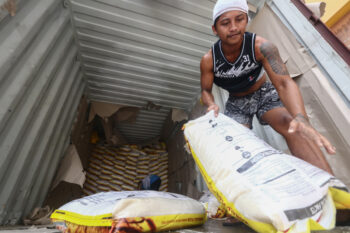GENERAL SANTOS CITY (MindaNews / 26 March) – The establishment of the Bangsamoro in lieu of the Autonomous Region in Muslim Mindanao before President Benigno Simeon C. Aquino III steps down on June 30, 2016, a done deal, will fulfill his wish. Will that also fulfill the vision of MILF Founding Chairman Salamat Hashim of a Moro state – autonomous if not independent – that will let the Moros govern themselves and enjoy their right to self-determination?
Setting up the Bangsamoro is laudable; making it truly fulfill a vision for the Moros will remain a struggle long after the euphoria of the inauguration. Although undaunted, the MILF (Moro Islamic Liberation Front) sees the daunting task of the BTA (Bangsamoro Transition Authority) to transition the Bangsamoro government within one year (it can be less) before its inauguration.
In a text message to MindaNews (March 23), OPAPP Secretary Teresita Quintos Deles, elated that the CAB (Comprehensive Agreement on Bangsamoro) was finally initialed last March 22, said, “– we made it! But, yes, can’t ever forget there’s lots more hard work ahead.” She might be referring to the challenges after the signing of the CAB which may delay more the signing of the BBL (Bangsamoro Basic Law) but not abort the inauguration; yet, that can be taken as a cue of what awaits the Bangsamoro after Aquino III.
Very Short Transition
Luwaran in its editorial (March 16, 2914: ‘No rocky hill for an iron will’) said the BTA would have daunting tasks to do when it “formally assumes power in 2015”. Within the “one year transition” the BTA has to “[1] set up institutions, write [2] the local government code, [3] the administrative code, and [4] the election code for the Bangsamoro. More importantly, [5] it has to provide leadership and unify the Bangsamoro people and rally them towards the vision set forth more than 40 years ago by the late MILF chair Salamat Hashim.”[Numbering supplied]
The five tasks are vital to how the Bangsamoro will turn out – boom or bust. They are keys to the realization of Point No. 2, “The Parties agree that the status quo is unacceptable …” of the “Decision Points on Principles” – the Bangsamoro a truly new political entity, not just a new name for the ARMM.
Task [1] will establish ministries, agencies and institutions proper to the ministerial form of government. Tasks [2], [3] and [4] will write instruments to define the Bangsamoro ministerial form of government and asymmetrical relation with the Central Government. Task [5] will unite the Moros as one Bangsa under the vision of MILF’s Founding Chairman Salamat Hashim.
Task No. 1: This is not a matter of staffing the ministries and institutions and devolving powers and functions to them from Manila. Suited to the ministerial form of government, they are bound by standards different from the unitary to make them more efficient than the status quo. But those who will be appointed to run these ministries, agencies and institutions are unfamiliar with the ministerial form of governance and have to learn-on-the-job. On paper, guiding theories and principles may look easy; but making them work effectively to be appreciated and accepted will take time and great efforts.
Task Nos. 2 and 3: For the regular Bangsamoro government to start on the right foot, it must have its own local government code and administrative code suitable to the ministerial form of government and asymmetrical relation with the Central Government. In fact, it must have its own tax code. These codes will bind the component local governments with the regional government to be truly autonomous. These codes do not have to be just written but to be subjected to test runs. To shake off the status quo, the Bangsamoro must have to start with its own codes.
Task No. 4: For the regular members of the Bangsamoro Legislative Assembly and local government officials in the Bangsamoro to be elected under its own election code is another imperative for the Bangsamoro to start on the right foot. The Bangsamoro Election Code is expected to free the Bangsamoro regional and local government officials from the tentacles of the national political parties through independent regional political parties. Again, to shake off the status quo, the Bangsamoro first election must be under its own election code.
Task No. 5: Providing leadership to unite the Moros as one Bangsa is the toughest challenge to MILF. Offered the same challenge, the MNLF failed. And rallying the Moro people behind the vision of Salamat Hashim is tougher still. Yet, it is the unity of the Moros in one vision that will make the Bangsamoro the “solution to the Bangsamoro Problem”.
Can these five tasks be accomplished in a one-year transition period – set up or written, tested and properly manned?
At risk is the imperative for MILF to be at the helm of Bangsamoro and remain there until its mission to solve the Bangsamoro Problem is fully accomplished. Inaugurating the Bangsamoro before President Aquino III steps down on June 30, 2016 will not be the accomplishment of the mission but just the beginning. Another group can derail or change entirely the Bangsamoro vision-mission, especially if MILF loses in the first election.
Impact on Election
Signing the CAB to cap the 17-year peace negotiation with the Philippine Government will not establish outright MILF leadership of the Bangsamoro. By negotiating with MILF, Government has recognized the MILF leadership; but MILF has to validate that recognition with the Moro people. Government recognized the MNLF leadership on signing the GRP-MNLF Final Peace Agreement in 1996. But MNLF failed to validate with the Moros that recognition; history has been unkind. Failing, too, MILF will repeat history.
The Bangsamoro is the political settlement MILF has negotiated with Government. And, this is the covenant it is offering to the Moro people: Support us and the Bangsamoro will free us all from centuries of injustices and deprivation. But to win that support, MILF has to demonstrate the worthiness of the Bangsamoro – demonstrate, not remonstrate.
The transition period is the time for that demonstration. If the Moros see the efficiency of the ministerial government under the Bangsamoro codes; if they avail of faster and better social services; if they see Bangsamoro funds honestly and well spent – if they see all these, they will appreciate the Bangsamoro and fully support the MILF leadership. But can all these be done in one year?
The transition period is also the time for MILF to establish its political party. It should transform the BTA into a political party to govern as a political party. It is also the time for other Moro groups to form political parties. These parties must be independent of and not beholden to any national political parties and organized down to the local government levels.
The Moros should learn a lesson from the status quo. Since the American period, Moro leaders have always been affiliated with national political parties playing second fiddle under the patronage system. The Moro interest has always been subordinated to the whims of the national leadership. That was the mistake of the MNLF. Its political leadership was tied to Malacañang. The Moros must elect their leaders on their own judgment, not on the dictation of Manila. Can regional parties fit to govern – not just wagons of election – be established in so short a time?
The impact of the transition period on the development and election of Moro leaders must not be taken for granted.
Impact on Unity
MILF must earn the full, unqualified trust of the Moros to lead the Bangsamoro. Politically and ethnically, the Moros are of diverse groups. The revolutionaries are of diverse splintered groups. As it is today, MILF is just one of the diverse groups with its loyal armed forces and civilian supporters. But it is not the entire Bangsamoro.
It must earn the support of traditional leaders by its own merits – not through the urging of the Aquino government to which those leaders owe their loyalty. It must earn the support of the MNLF-Misuari and other groups, of the Abu Sayyaf and of its own splinter BIFF (Bangsamoro Islamic Freedom Fighters). Predominantly of the Maguindanao and Maranaw ethnicity, it must earn the full support of the Tausug, Samal and other ethnic groups. In fact, it must earn the support of the politically defunct but still cohesive Sulu Sultanate.
It can reach out to these diverse groups through dialogue or negotiation. The best way, however, is to give life to the vision of Salamat Hashim as the rallying point of the Moro liberation. The transition period is the time to do this. If leaders of these diverse groups see the Moro people fully supporting the MILF mission following the Salamat vision, in all probability – hopefully – they will support the Bangsamoro. Can MILF do this in a one-year transition period – or shorter?
Test of Sincerity
The transition period is not a mere motion to transfer government from ARMM to Bangsamoro; it is to establish the firm political, social and economic foundations of Bangsamoro. If the Aquino government is sincere in making the Bangsamoro the solution to the Moro and peace problems in Mindanao – not just to establish a legacy for President Aquino III and earn plaudits worldwide – it should realize the inconsistency of the very short transition to what must be done during the transition to build the Bangsamoro on a strong foundation.
Let’s be realistic. Without delay, the Congress is expected to enact the BBL by the end of 2014; it will be ratified in the first quarter of 2015. That will leave only nine months in 2015 for the transition period. That will be about all there is for transition work; January to May 2016 will be the election period. But the BBL may be questioned in the Supreme Court. If that happens, the transition will be a mere motion.
Luwaran is right: One year transition period is very short by any standard. Secretary Deles is also right seeing “there’s lots more hard work ahead” – although she might not be referring to the imperatives of the Bangsamoro transition.
MILF Chairman Murad Ibrahim agreed to cut to three years the original demand of six years of transition period. We believe he meant transition proper – not including the pre-transition or the drafting, enactment and ratification of the BBL. To reciprocate, if it is sincere, the Aquino III government must allow the three-year transition period starting from the BTA’s takeover of the ARMM. In reality, the takeover is the official establishment of the Bangsamoro.
The BTA is tasked to firmly establish the Bangsamoro before the election of its regular officials. Since time to do this is very short within the Aquino III term, wisdom dictates that the transition must be extended to the next administration. Yet, whether wisdom prevails or not, MILF – to use its own analogy — will have steep “rocky hills” to defy its “iron will” immediately before and after President Aquino III steps down on June 30, 2016.
(To Be Continued)
(“Comment” is Mr. Patricio P. Diaz’ column for MindaViews, the opinion section of MindaNews. The Titus Brandsma Media Awards recently honored Mr. Diaz with a “Lifetime Achievement Award” for his “commitment to education and public information to Mindanawons as Journalist, Educator and Peace Advocate.” You can reach him at patpdiazgsc@yahoo.com.)






